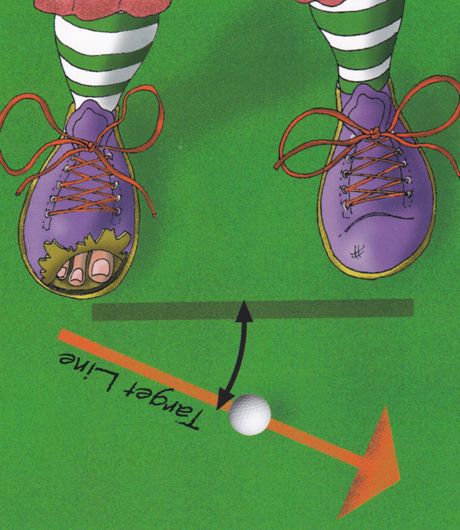Why the open stance?
 When hitting a normal full shot, ideal set-up alignment features our feet, knees, hips, and shoulders parallel to the target line. For shorter shots, such as pitches and chips, ideal alignment means having an open stance at address.
When hitting a normal full shot, ideal set-up alignment features our feet, knees, hips, and shoulders parallel to the target line. For shorter shots, such as pitches and chips, ideal alignment means having an open stance at address.
This may confuse certain students as to why this is necessary, and it may also confuse some teachers as to the correct explanation. Actually, the reason is very simple.
Through impact, the hips must be open to the path of the hands and clubhead to allow the hands and arms to continue into the follow-through unobstructed. If the hips are square, the only way to go into the follow-through is with a chicken-wing of the lead arm.
With a normal full shot, the body turns aggressively towards the target during the downswing. Even though we set up our entire body square to the target line, the hips will naturally open up at impact, assuming the person has a halfway decent golf swing. Often, though, our students do not turn their hips adequately during the downswing, and we see the chicken-wing of the lead arm manifest itself. This is because straightened arms are, in effect, blocked by the square hips from continuing their path to the top of the follow through.
For pitch shots and chip shots, there is a much less aggressive turning of the body through impact. This is especially true for chip shots, as the chipping motion more closely mirrors a putting stroke. To overcome the less aggressive hip turning through impact, ideally we want to set up with an open stance to the target line with our body lines. This ensures open hips through impact, and the result is our arms can swing freely without manipulation to the follow-through position.
Believe it or not, this also comes into play with putting. Although it is common for teachers to tell students that their entire body alignment should be parallel to the target line, most tour professionals set up with open feet, knees, and hips (with the shoulders remaining square to allow a proper putter path). Again, this open alignment of the lower body allows the arms to swing down the target line in a free manner.
Try this experiment: pretend you are in the impact position with a square lower body (feet, knees, and hips parallel to the target line). Right away, this should feel unnatural. Now, try to swing your arms into the follow-through position while keeping your lower body square to the target line. Unless you are a professional contortionist, it’s impossible without chicken-winging the lead arm.
The importance of open hips at impact, even for the short shots, cannot be overestimated. If you make sure your students achieve this, they should see improved results in their entire golf game.




